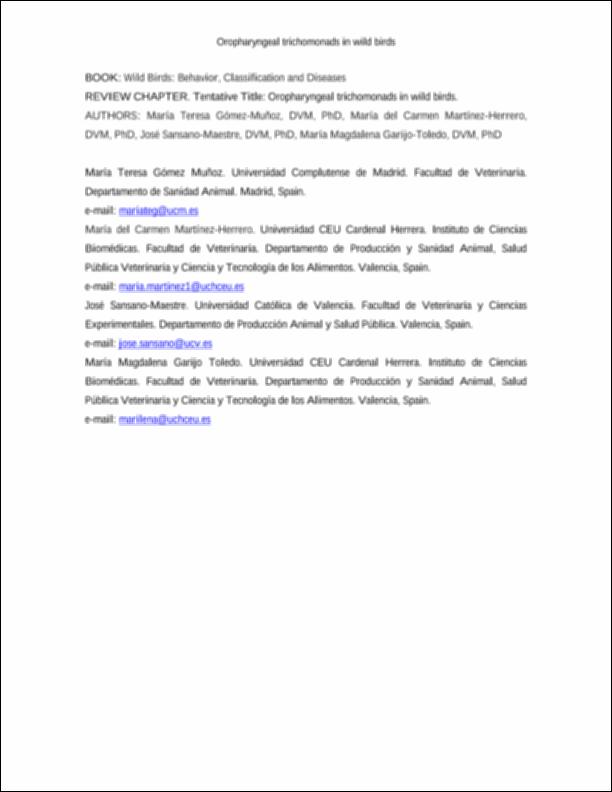Please use this identifier to cite or link to this item:
http://hdl.handle.net/10637/10716Oropharyngeal trichomonads in wild birds
| Title: | Oropharyngeal trichomonads in wild birds |
| Authors : | Gómez Muñoz, María Teresa Martínez Herrero, María del Carmen Sansano Maestre, José Garijo Toledo, María Magdalena |
| Keywords: | Aves de presa - Enfermedades.; Tricomoniasis.; Trichomoniasis.; Enfermedades infecciosas.; Aves - Enfermedades.; Communicable diseases.; Birds of prey - Diseases.; Birds - Diseases. |
| Publisher: | Nova Science. |
| Citation: | Gómez-Muñoz, MT., Martínez-Herrero, MC., Sansano-Maestre, J. & Garijo-Toledo, MM. (2018). Oropharyngeal trichomonads in wild birds. En Jenkins, Owen P. (ed.) (2018). Advances in Animal Science and Zoology. Volume 11 (pp. 1-41). Hauppauge (Nueva York, Estados Unidos) : Nova Science. |
| Abstract: | Oropharyngeal trichomonosis is a disease that affects wild and domestic birds. Some studies carried out in wildlife recovery centers pointed it out as the main cause of entrance of birds of prey due to infectious diseases. It causes small nodules and ulcers in the crop and other locations of the upper digestive system of the animals. These small lesions can coalesce and form large granulomas, which can provoke the death of the animal by starvation. Trichomonas gallinae is considered the etiological agent of the disease, a flagellated protozoon that is frequently found in the oral cavity of columbiformes, which are considered the main reservoir of the parasite. However, in the last decade, a great progress in the molecular characterization of this and other protozoa has been reached, and the number of genetic variants and even new species within the trichomonads that inhabit the avian oropharynx has expanded. In this review, we outline the latest descriptions of these parasites and their host spectrum; more than 10 genetic variants or new species are included. Although trichomonosis has been described in several groups of birds, the higher impact is usually found on Accipitriformes, Falconiformes and Strigiformes due to their predation or scavenging habits. Psittaciformes and Passeriformes also show clinical signs of the disease, and recently, several epidemic episodes of trichomonosis in fringilids were described across Europe and North America. In addition, chicks of endangered species like the Bonelli´s eagle (Aquila fasciata) are frequently affected by the parasite, as several studies carried out in Spain and nearby countries have proved. In this chapter, we summarize the most important features of the disease, including the biology, the diagnosis and treatment options. Additionally, we will describe the recent scientific advances in the pathology, epidemiology and control of the disease. |
| Description: | Este es el pre-print del siguiente capítulo de monografía: Gómez-Muñoz, MT., Martínez-Herrero, MC., Sansano-Maestre, J. & Garijo-Toledo, MM. (2018). Oropharyngeal trichomonads in wild birds. En Jenkins, Owen P. (ed.) (2018). Advances in Animal Science and Zoology. Volume 11 (pp. 1-41). Hauppauge (Nueva York, Estados Unidos) : Nova Science. This is the pre-peer reviewed version of the following chapter of monography: Gómez-Muñoz, MT., Martínez-Herrero, MC., Sansano-Maestre, J. & Garijo-Toledo, MM. (2018). Oropharyngeal trichomonads in wild birds. En Jenkins, Owen P. (ed.) (2018). Advances in Animal Science and Zoology. Volume 11 (pp. 1-41). Hauppauge (Nueva York, Estados Unidos) : Nova Science. |
| URI: | http://hdl.handle.net/10637/10716 |
| Rights : | http://creativecommons.org/licenses/by-nc-nd/4.0/deed.es |
| ISBN: | 9781536132144 |
| Issue Date: | 20-Nov-2018 |
| Center : | Universidad Cardenal Herrera-CEU |
| Appears in Collections: | Dpto. Producción y Sanidad Animal, Salud Pública Veterinaria y Ciencia y Tecnología de los Alimentos |
Items in DSpace are protected by copyright, with all rights reserved, unless otherwise indicated.


